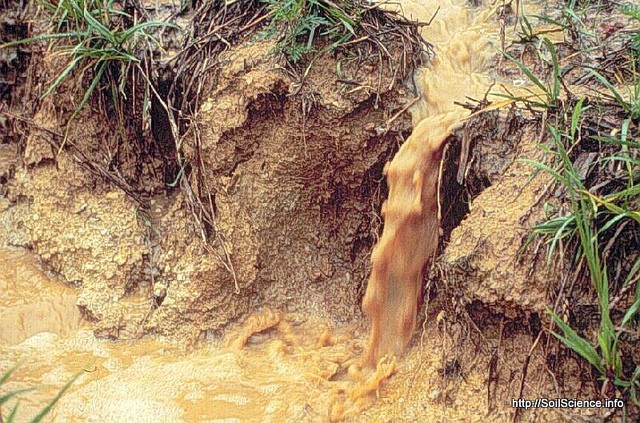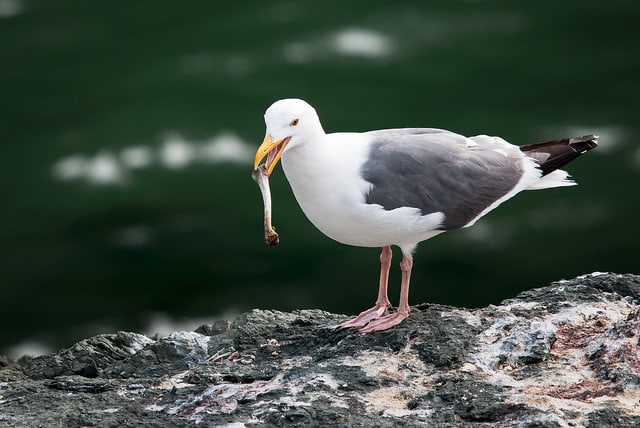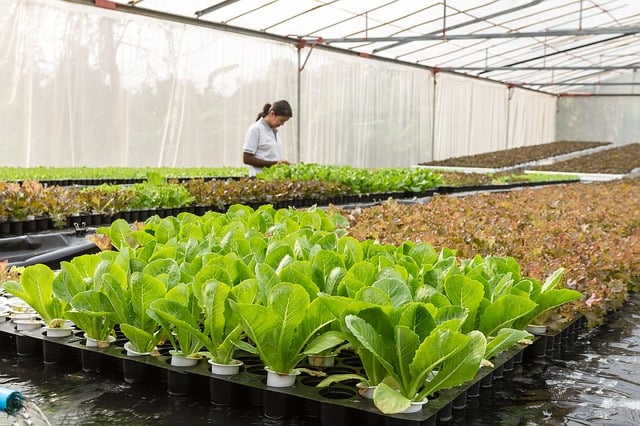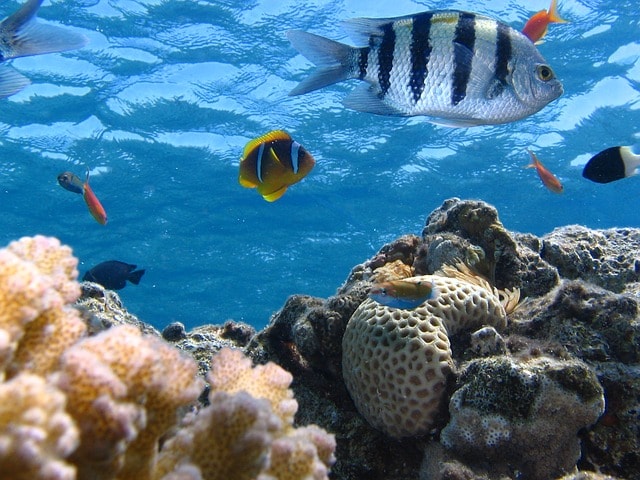Causes and Effects of Eutrophication
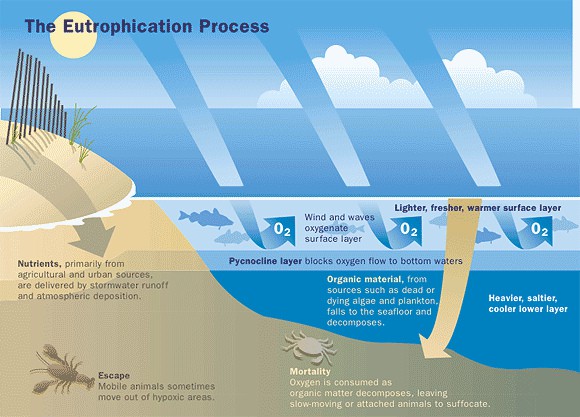
Eutrophication is characterized by dense algal and plant growth owing to increased concentration of chemical nutrients needed for photosynthesis. It mainly arises from the oversupply of phosphate and nitrate nutrients. As such, increased levels of chemical nutrients from animal waste, fertilizers and sewage often give rise to eutrophication when washed into nearby surface waters by rain or irrigation.
Eutrophication also occur natural over thousands of years as the lakes grow old and filled with sediments. Still, human activities have sped up the degree and rate of eutrophication through both point-source and non-point source discharges of the chemical nutrients (phosphates and nitrates) into aquatic systems. Some of the consequences of eutrophication include destruction of aquatic systems and reduction in water quality.
As per Wikipedia,
“Eutrophication or more precisely hypertrophication, is the ecosystem’s response to the addition of artificial or natural nutrients, mainly phosphates, through detergents, fertilizers, or sewage, to an aquatic system. One example is the “bloom” or great increase of phytoplankton in a water body as a response to increased levels of nutrients. Negative environmental effects include hypoxia, the depletion of oxygen in the water, which may cause death to aquatic animals.“
Causes of Eutrophication
- Fertilizers (nitrates and phosphates)
Eutrophication is predominantly caused by human action. Agricultural practices and the use of fertilizers on lawns, golf courses, and other fields contribute to nutrient accumulation. When these nutrients with high concentrations of phosphorous and nitrogen are washed by surface runoff into lakes, rivers, oceans and other surface waters when it rains, the hungry plankton, algae and other aquatic plant life are well fed and their photosynthesis activity is increased. This causes dense growth of algal blooms and plant life in the aquatic environments.
- Concentrated animal feeding operations
Concentrated animal feeding operations (CAFOs) are as well a main contributor of phosphorus and nitrogen nutrients responsible for eutrophication. The concentrated animal feeding operations normally discharge the nutrients that find way into rivers, streams, lakes, and oceans where they accumulate in high concentrations thereby plaguing the water bodies by recurring cyanobacterial and algal blooms.
- Direct sewage discharge and industrial waste into water bodies
In some parts of the world, especially the developing nations, sewage water is directly discharged into water bodies such as rivers, lakes, and oceans. As a result, it introduces high amounts of chemical nutrients therefore stimulating the dense growth of algal blooms and other aquatic plants which threatens survival of aquatic life in many ways.
Some countries may also treat the sewage water, but discharge it into water bodies after treatment. As much as the water is treated, it can still cause the accumulation of excess nutrients, ultimately bringing about eutrophication. The direct discharge of industrial waste water into water bodies presents similar outcomes.
- Natural events
Natural events such as floods and the natural flow of rivers and streams can also wash excess nutrients off the land into the water systems thus causing excessive growth of algal blooms. Also, as lakes grow old, they naturally accumulate sediments as well as phosphorus and nitrogen nutrients which contribute to the explosive growth of phytoplankton and cyanobacterial blooms.
Effects of Eutrophication
- Threatens the survival of fish and other aquatic life forms
When aquatic ecosystems experience increased nutrients, the phytoplankton and other photosynthetic plants grow explosively, commonly known as algal blooms. As an outcome, the algal blooms limit the amount of dissolved oxygen required for respiration by other animal and plant species in the water. Oxygen depletion happens when the algae/plant life die and decompose.
When the dissolve oxygen reaches hypoxic levels, the animal and plant species under the water such as shrimp, fish and other aquatic biota suffocate to death. In extreme cases, the anaerobic conditions encourage the growth of bacteria that produces toxins that are deadly to marine mammals and birds. This can bring about aquatic dead zones and lessens biodiversity.
- Deterioration of water quality and limits access to safe drinking water
Algal blooms are highly toxic and once the water reaches the anaerobic conditions, the growth of more toxic bacterial is promoted. The consequence is extensive deterioration of water quality and decline in the availability of clean drinking water. The dense growth of algal blooms and photosynthetic bacteria in surface waters can also block water systems hence, limiting the availability of piped water.
On this regard, toxic algal blooms have shut down numerous water supply systems across the globe. In 2007, for instance, more than 2 million residents of Wuxi, China could not access piped drinking water for more than a week due to severe attack by algal blooms on Lake Taihu.
- Poisoning and impact on human health
The cyanobacteria, also referred to as dinoflagelates which generates red tide, release very powerful toxins with high poison levels in the water even at very low concentrations. The anaerobic conditions created by explosive plant growth in the water also results in the doubling of the toxic compounds.
It can also cause death in humans and animals even at the least concentration when ingested in drinking water. Freshwater algal blooms can threaten livestock health. The toxic compounds can also make their way up the food chain, contributing to various negative health impacts such as cancers.
Biotoxins are linked to increased incidence of neurotoxic, paralytic, diarrhoetic shelfish poisoning in humans, which can lead to death. The shellfish accumulate the poison in their mussles and then poisions humans upon consumption. High nitrogen concentraion in drinking water is associated with the ability of inhibiting blood circulation in infants, a condition known as blue baby syndrome.
- Endangers fishing
One of the main characteristic of eutrophication as pointed out earlier is the increased growth of minute floating plants such as algae and photosynthetic bacteria and the development of extensive and dense mats of floating plants such as Nile cabbage and water hyacinths. Whenever this happens on a water body, fishing is endangered. It simply becomes difficult to set the fishing nets in water and the plants floating on water limits the mobility of boats and other fishing vessels.
- Degradation of recreational opportunities
The main problem of eutrophication is the algal blooms and other aquatic plants that float on an extensive area of the water surface. It reduces the transparency and navigation in the water which lessens the recreational values and opportunities of the lakes, especially for boating and swimming. Nile cabbage, algal blooms, and water hyacinth can spread over an extensive area along the shores and can sometimes float over the entire surface into the land area.


